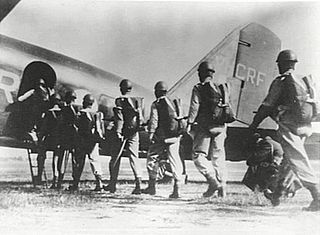 W
WThe 1st Parachute Battalion was a parachute infantry battalion of the Australian Army. Raised for service during the Second World War, it was formed in early 1943 from volunteers for airborne training. Despite achieving a high level of readiness, the battalion did not see action during the war and was disbanded in early 1946.
 W
WThe 1st Battalion was an infantry battalion of the Australian Army. Although its numerical name was designated during the First World War, the 1st Battalion can trace its lineage back to 1854, when a unit of the Volunteer Rifles was raised in Sydney, New South Wales. This unit has since been redesignated a number of times, but through its links with the units of the colonial NSW defence force, the battalion's history includes services in Sudan and South Africa. During the First World War, the 1st Battalion was raised for overseas service in 1914 as part of the First Australian Imperial Force. Attached to the 1st Brigade, the battalion served in Egypt initially before taking part in the fighting in Gallipoli against the Turks. Later the battalion was sent to the Western Front where it fought in the trenches in France and Belgium as part of the Australian Corps. Following the end of the war the battalion was disbanded in 1919.
1st Battalion, Royal Australian Regiment is a regular motorised infantry battalion of the Australian Army. 1 RAR was first formed as the 65th Australian Infantry Battalion in 1945 and since then has been deployed on active service during the Korean War, the Malayan Emergency, the Vietnam War and more recently in Somalia, East Timor, Iraq and Afghanistan. Additionally, the battalion has deployed on peacekeeping operations to a number of countries including Japan, East Timor and the Solomon Islands. In 2006, 1 RAR was one of the Australian Army's most heavily deployed units sending detachments to Iraq as part of SECDET, Tonga, the Solomon Islands and Timor Leste. The battalion is currently based at Townsville, Queensland, where it forms part of the 3rd Brigade.
 W
WThe 1st New Guinea Infantry Battalion was a battalion of the Australian Army during World War II. One of four infantry battalions raised in New Guinea, 1 NGIB was formed in March 1944. In late 1944, the battalion began deploying company-sized elements in support of combat operations on Bougainville, New Britain and on mainland New Guinea. It later became part of the Pacific Islands Regiment before being disbanded in June 1946.
 W
WThe 2nd Battalion, Royal Australian Regiment is an amphibious light infantry battalion of the Australian Army part of the 1st Division Amphibious Task Group based at Lavarack Barracks in Townsville.
 W
WThe 2nd Commando Regiment is a special forces unit of the Australian Army, and is part of Special Operations Command. The regiment was established on 19 June 2009 when the 4th Battalion, Royal Australian Regiment (Commando) was renamed. It is based at Holsworthy, New South Wales. The 2nd Commando Regiment often trains and deploys with the Special Air Service Regiment, is highly regarded by coalition special operation forces abroad, and has been involved in operations in East Timor, Iraq and Afghanistan, where it was used in a direct action warfighting role. It has also been involved in a number of domestic security operations including the 2006 Commonwealth Games and the 2014 G20 Leaders Summit.
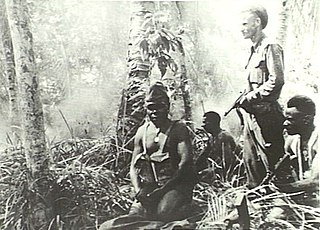 W
WThe 2nd New Guinea Infantry Battalion was a battalion of the Australian Army during World War II. One of four infantry battalions raised in New Guinea, 2 NGIB was formed in September 1944. Formed late in the war, the battalion played only a minor role in the Allied campaign in New Guinea, supporting the 6th Division during the final stages of the Aitape–Wewak campaign. In 1945, it became part of the Pacific Islands Regiment, but was disbanded in June 1946.
 W
WThe 3rd Battalion, The Royal Australian Regiment is a mechanised infantry battalion of the Australian Army, based in Townsville as part of the 3rd Brigade. 3 RAR was initially formed in 1945 as the 67th Battalion and has seen active service in Japan, Korea, Malaya, South Vietnam, East Timor, the Solomon Islands, Afghanistan and Iraq.
 W
WThe 3rd New Guinea Infantry Battalion was a battalion of the Australian Army during World War II. One of four infantry battalions raised in New Guinea to fight against the Japanese, 3 NGIB was formed in June 1945, and spent the remainder of the war training. After becoming operational, it was sent to New Britain where it undertook garrison duties around Rabaul in the post war period. It later became part of the Pacific Islands Regiment before being disbanded in November 1947.
The 4th Battalion, Royal Australian Regiment was an Australian Army infantry battalion and part of the Royal Australian Regiment. The battalion was formed on 1 February 1964 and was renamed the 2nd Commando Regiment on 19 June 2009.
 W
WThe 4th New Guinea Infantry Battalion was a battalion of the Australian Army. One of four infantry battalions raised in New Guinea, 4 NGIB was formed in the final stages of World War II to fight against the Japanese. It eventually became part of the Pacific Islands Regiment, but due to the abrupt ending to the war, the battalion did not see action against the Japanese and was disbanded in October 1945 without seeing active service.
The 5th Battalion, Royal Australian Regiment is a regular motorised infantry battalion of the Australian Army. Originally established in 1965 it would serve two tours of South Vietnam before it was linked with the 7th Battalion to form the 5th/7th Battalion, Royal Australian Regiment in 1973. In late 2006 the two units were de-linked, and 5 RAR again joined the Australian Army's order of battle in its own right. It has since served in Iraq, East Timor and Afghanistan.
 W
WThe 6th Battalion was an infantry battalion of the Australian Army. Originally formed in 1914 for service during the First World War, the battalion fought at Gallipoli and on the Western Front. The battalion was disbanded in 1919 but was re-raised in 1921 as part of the Citizens Force, and adopted the title of "Royal Melbourne Regiment" in 1935. The battalion did not serve overseas during the Second World War and was eventually disbanded in 1944. It was re-raised in 1948 and remained in existence until 1960 when it was absorbed into the Royal Victoria Regiment. Today its honours and traditions are maintained by the 5th/6th Battalion, Royal Victoria Regiment.
6th Battalion, Royal Australian Regiment is a mechanised infantry battalion of the Australian Army. It was originally raised in Brisbane, Queensland, on 6 June 1965 and has since then served in a number of overseas deployments and conflicts including South Vietnam, East Timor, Iraq and Afghanistan. During the Vietnam War, the battalion earned a US Presidential Unit Citation from the United States when members from 'D' Company participated in the Battle of Long Tan on 18–19 August 1966. The battalion is currently based at Gallipoli Barracks in Brisbane and forms part of the 7th Brigade.
 W
WThe 7th Battalion, Royal Australian Regiment is a regular infantry battalion of the Australian Army. It was originally raised in 1965 as part of Australia's commitment to the Vietnam War and it eventually served two tours in Vietnam in 1967 and 1971. In 1973, following Australia's withdrawal from the conflict, the battalion was amalgamated with the 5th Battalion, Royal Australian Regiment to form the 5th/7th Battalion, Royal Australian Regiment.
The 8th Battalion, Royal Australian Regiment was an Australian Army Regular infantry battalion. The battalion was formed in July 1966 as part of an expansion of the Australian Army in the mid-1960s due to the perceived threat of Communism in southeast Asia. Initially the battalion was sent to Malaysia in 1967, before later being sent to South Vietnam as part of Australia's commitment to the Vietnam War. Between November 1969 and October 1970 the battalion undertook operations as part of the 1st Australian Task Force, before being brought back to Australia. In October 1973, after Australia's involvement in Vietnam officially ended, the battalion was amalgamated with 9 RAR to form 8/9 RAR.
 W
WThe 9th Battalion, Royal Queensland Regiment is a Reserve light infantry battalion of the Australian Army, raised and based in the state of Queensland. It is part of the Royal Queensland Regiment and is currently attached to the 11th Brigade of the 2nd Division. 9 RQR can trace its history as far back as 1867 with the establishment Queensland Volunteer Rifle Corps, although it was not until 1911 that it was designated as the "9th Battalion". Over the course of its history, the battalion has served Australia in a number of conflicts including The Boer War, World War I and World War II, while more recently, members of the battalion have been involved in various peacekeeping operations and exercises around the Pacific region.
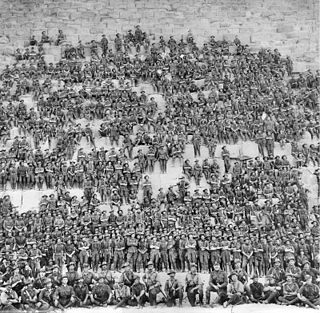 W
WThe 11th Battalion was an Australian Army battalion that was among the first infantry units raised during World War I for the First Australian Imperial Force. It was the first battalion recruited in Western Australia, and following a brief training period in Perth, the battalion sailed to Egypt where it undertook four months of intensive training. In April 1915 it took part in the invasion of the Gallipoli Peninsula, landing at Anzac Cove. In August 1915 the battalion was in action in the Battle of Lone Pine. Following the withdrawal from Gallipoli, the battalion returned to Egypt where it was split to help form the 51st Battalion. In March 1916, the battalion was deployed to the Western Front in France and Belgium where it took part in trench warfare until the end of the war in November 1918.
 W
WThe 15th Battalion was an infantry battalion of the Australian Army. Formed in 1914 as part of the all-volunteer Australian Imperial Force from Queensland and Tasmanian recruits, the battalion fought during the Gallipoli Campaign and on the Western Front during the First World War. It was disbanded after the war in 1919, but later re-raised as a part-time Citizens Forces unit based in Queensland in 1921, consisting of a mixture of volunteers and conscripts. Economic pressures and limited manpower resulted in the battalion being amalgamated with other battalions a couple of times during the inter-war years. In mid-1939, as rising tensions in Europe led to an expansion of the Australian military, the battalion was re-formed in its own right. During the Second World War the 15th Battalion was mobilised for wartime service and initially undertook defensive duties in Australia before taking part in the fighting against the Japanese in New Guinea and Bougainville in 1943–1945. The battalion was disbanded in 1946 and never re-raised.
 W
WThe 16th Battalion, Royal Western Australia Regiment is an Australian Army reserve infantry battalion located in Western Australia and one of the two battalions of the Royal Western Australia Regiment. The battalion was first formed during the First World War, during which it fought during the Gallipoli Campaign and on the Western Front in France and Belgium as part of the Australian Imperial Force. It was re-formed as a part-time unit in Western Australia during the inter-war years, and served in the New Britain Campaign against the Japanese during the Second World War. In the post war years, the battalion became part of the Royal Western Australia Regiment and currently forms part of the 13th Brigade.
 W
WThe 31st Battalion, Royal Queensland Regiment was a Reserve infantry battalion of the Australian Army. Although it was officially formed as 31 RQR in 1965 the battalion can trace its lineage back to units formed in 1881 as part of the colonial defence forces of the state of Queensland.
 W
WThe 41st Battalion, Royal New South Wales Regiment,, is an infantry battalion of the Australian Army. An Army Reserve unit, it is one of four battalions of the Royal New South Wales Regiment and is attached to the 5th Brigade, 2nd Division. It is based in northern New South Wales, with its headquarters in Lismore and depots in a number of locations including Tweed Heads, Grafton, Kempsey, Port Macquarie and Coffs Harbour. In its present form the battalion was raised in 1965, however, it can trace its lineage back to a couple of Scottish Rifles units formed in the 1800s in Byron Bay and Maclean. It also perpetuates the battle honours and traditions of the 41st Bn AIF, that served on the Western Front during World War I.
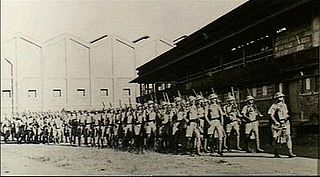 W
WThe Darwin Mobile Force was a mixed force of infantry and artillery raised by the Australian Army prior to the Second World War. It was the first regular infantry field force in the Australian military, although due to legislative restrictions that existed at the time it was established as part of the Royal Australian Artillery. Its formation marked a rare departure from the traditional Australian focus upon part-time citizen forces and is arguably a key moment in the development of a professional standing army. Attached to the 7th Military District, the Darwin Mobile Force were used to garrison the strategic port of Darwin in the Northern Territory, along with 9th Heavy Battery and the 7th Fortress Engineers, RAE, and to provide personnel with training and command experience. The force ceased to exist in August 1940 when its personnel were broken up and sent to other units.
 W
WThe Jungle division was a military organisation adopted in early 1943 by the Australian Army during the Second World War. This organisation was a much lighter version of the standard British-pattern infantry division used during previous campaigns in the deserts of the Mediterranean and Middle East Theatre fighting the Germans and Italians in 1940 and 1941 and was optimised to meet the needs of jungle warfare against the Japanese in the South West Pacific Area. Jungle divisions were smaller and had fewer heavy weapons, vehicles and support units than the British-pattern division previously used and had an establishment of just 13,118 men, approximately 4,000 fewer than a standard division. The bulk of the reduction occurred among the administrative, transport and artillery units. The conditions that prevailed in the South West Pacific Area led the Australian Army to initially convert five infantry divisions to Jungle divisions, although this was later increased to six. Divisions converted to the jungle organisation included three Militia divisions: the 3rd, 5th and 11th and the three Australian Imperial Force (AIF) divisions: the 6th, 7th, 9th. Despite some modifications, this re-organisation proved successful during later Australian operations in New Guinea, New Britain, Bougainville, Aitape-Wewak and Borneo in 1944–45.
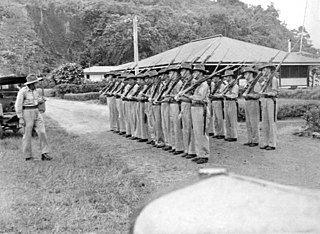 W
WThe New Guinea Volunteer Rifles (NGVR) was an infantry battalion of the Australian Army. It was initially raised as a unit of the Militia from white Australian and European expatriates in New Guinea upon the outbreak of the Second World War in 1939, before being activated for full-time service following the Japanese landings in early 1942. NGVR personnel then helped rescue survivors of Lark Force from Rabaul in February and March 1942. Between March and May, the NGVR monitored the Japanese bases which had been established in the Huon Gulf region, being the only Allied force in the area until the arrival of Kanga Force at Wau in May. The battalion subsequently established observation posts overlooking the main approaches and reported on Japanese movements.
 W
WThe Papuan Infantry Battalion (PIB) was a unit of the Australian Army raised in the Territory of Papua for service during the Second World War. Formed in early 1940 in Port Moresby to help defend the territory in the event of a Japanese invasion, its soldiers were primarily Papuan natives led by Australian officers and non-commissioned officers. Following the outbreak of the Pacific War, the PIB served in many of the Allied campaigns in New Guinea; however, due to the nature of its role its sub-units mainly operated separately, attached to larger Australian and US Army units and formations. Slow in forming, the first members of the PIB were not officially posted in until March 1941. By 1942 it consisted of only three companies, all of which were under-strength and poorly equipped. It was subsequently employed on scouting, reconnaissance and surveillance patrols against the Japanese, where the natural bushcraft of its native soldiers could be used to their advantage. The PIB was sent forward in June 1942 to patrol the northern coast of Papua and was dispersed over a wide area. These small parties were the first to make contact with the Imperial Japanese forces upon their landing in Papua, before participating in the Kokoda Track campaign. As part of Maroubra Force, the PIB fought alongside the Australian 39th Battalion at Kokoda, Deniki, and Isurava as the Japanese forced them back along the Kokoda track, but was withdrawn before the campaign finally turned in favour of the Australians.
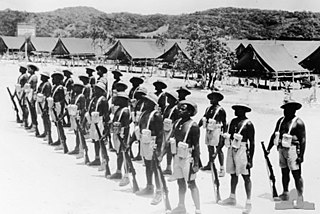 W
WThe Torres Strait Light Infantry Battalion was an infantry battalion of the Australian Army during the Second World War. Initially raised as a company-sized unit in 1941, it was expanded to a full battalion in 1942 and was unique in that almost all of its enlisted men were Torres Strait Islanders, making the battalion the only Indigenous Australian battalion ever formed by the Australian Army. The battalion was used mainly in the garrison role, defending the islands of the Torres Strait, although in 1943 a detachment was sent to patrol Dutch New Guinea. Following the end of the war, the battalion was disbanded in 1946.
 W
WThe Volunteer Defence Corps (VDC) was an Australian part-time volunteer military force of World War II modelled on the British Home Guard. The VDC was established in July 1940 by the Returned and Services League of Australia (RSL) and was initially composed of ex-servicemen who had served in World War I. The government took over control of the VDC in May 1941, and gave the organisation the role of training for guerrilla warfare, collecting local intelligence and providing static defence of each unit's home area. General Harry Chauvel, who had retired in 1930, was recalled to duty in 1940 and appointed Inspector-General of the VDC. Chauvel held this position until his death in March 1945.